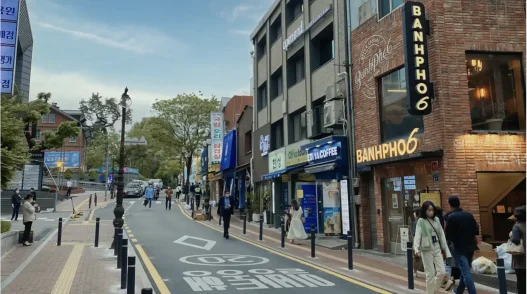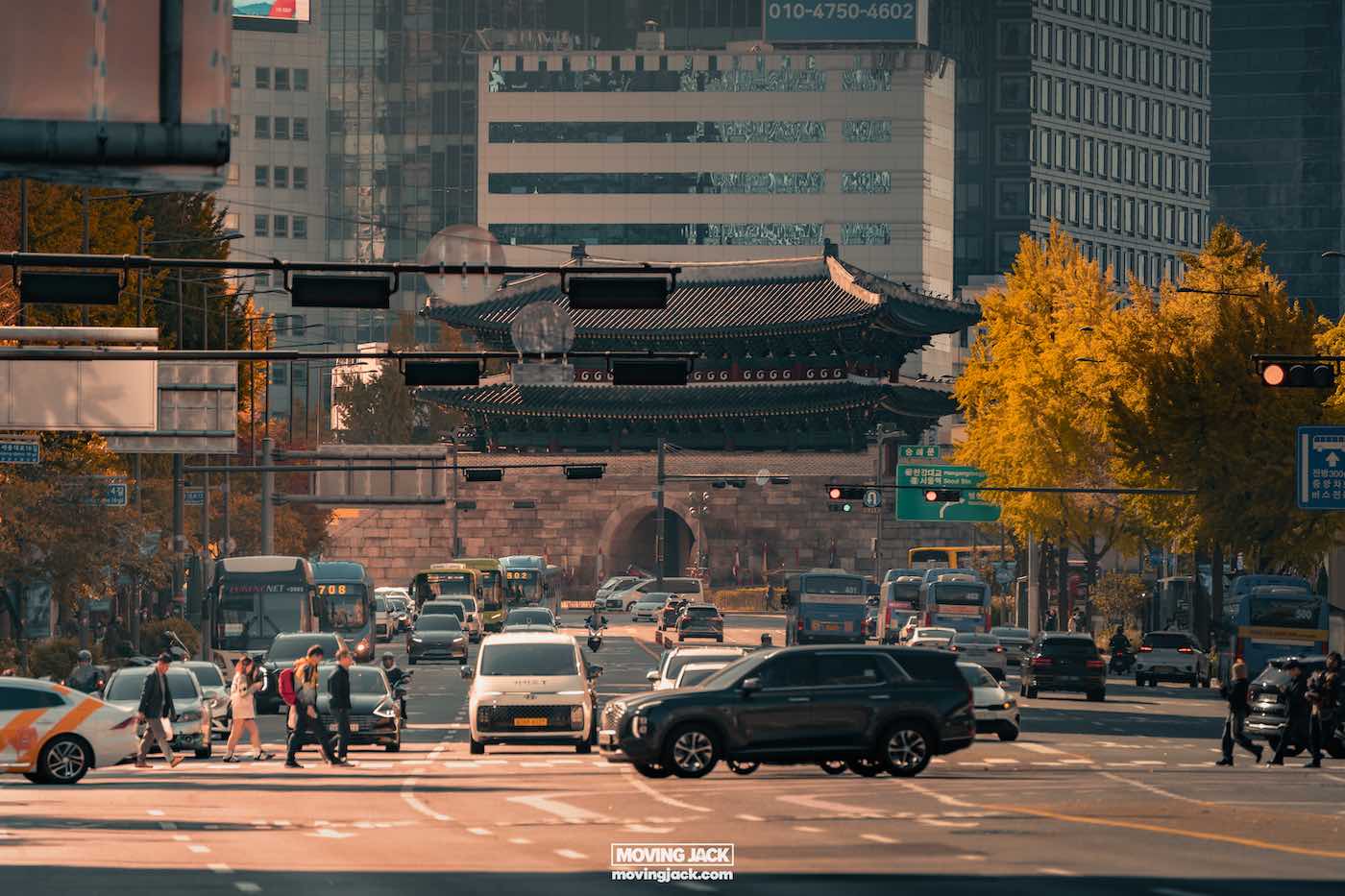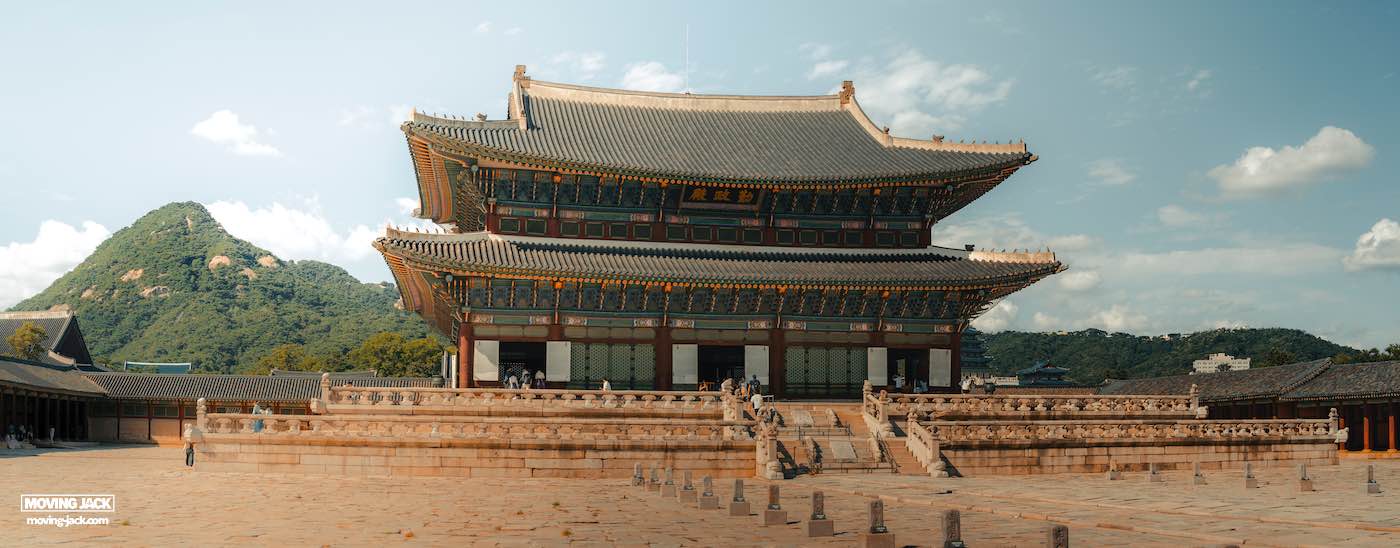Living in Seoul has been such a good experience that I’d recommend it to anyone thinking about relocating abroad.
It’s a city that’s convenient, safe, and affordable (when making the right choices). There’s a lot to explore, culture, nature, and history-wise. And there are many incredible destinations that are easy to reach from Seoul with a short flight.
In this ultimate guide, I will share my completely raw and honest take (not all is positive, but most is!) on everything I learned about living in Seoul.
I’ll cover the costs, the culture, getting around, unexpected pros and cons, and much more.
Because this turned out to be such a comprehensive post, I added short summaries (TL;DR) to every chapter.

Cost of Living and Housing in Seoul
When people ask about living in Seoul, the first question I almost always get is: “But isn’t it expensive?”
The short answer: it really depends on your lifestyle and choices.
TL;DR
Expect to spend around $2,500/month for a family of 3, excluding rent. The housing system works with either a massive deposit (Jeonse) or a smaller deposit plus monthly rent (Wolse), but companies usually handle this for expats. Korean food and public transport are cheap, but imported products and taxis are a bit more expensive.
If you’re coming from a Western city like London, New York, or Amsterdam, Seoul will probably feel kind of affordable in many ways, especially when it comes to:
- Transportation (except taxis)
- Eating out at local restaurants
- Cultural things to do
- Tech products (yay!)
- Daycare (also yay!)
But if you’re arriving from elsewhere in Asia, the Middle East, or Eastern Europe, you’ll quickly notice that the city can also be more expensive than expected, especially rent, eating out at international restaurants, taxis, parking in some places, and Western products.
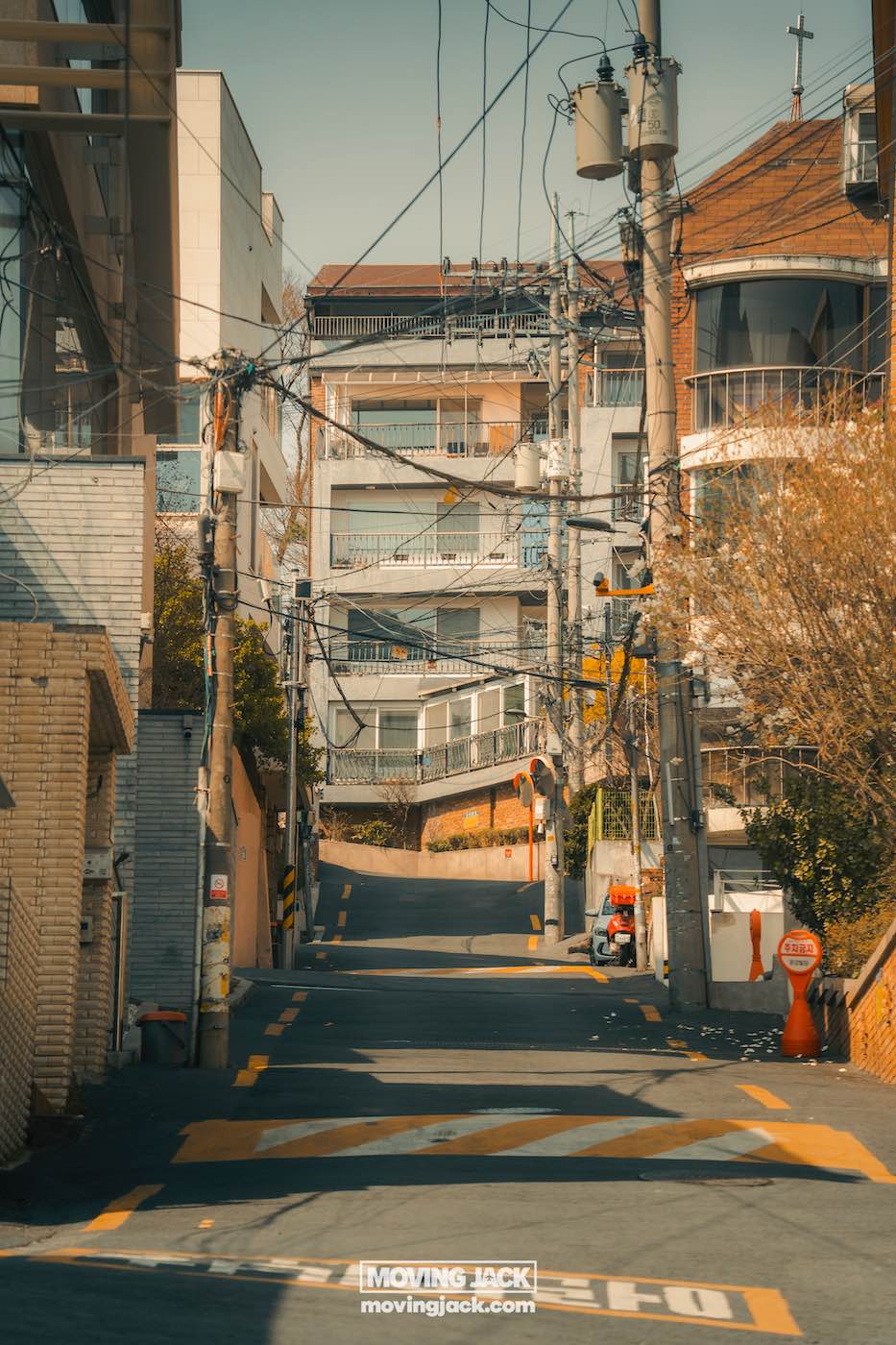
Our costs in a typical month for our family of 3:
Here are the costs we typically have in a month, excluding rent. I excluded rent because it varies so much for everyone.
If you want to know what a house costs to rent in various neighborhoods in Seoul, you can look up prices on this Real Estate site
Here are our monthly costs:
- Utilities ₩ 150,000 ($112) Electric, gas, water
- Internet ₩ 60000 ($44) 1Gbps fiber internet
- Phone (2 lines) ₩ 100,000 ($80) Unlimited data (More expensive than I thought it would be)
- Car Insurance (all-risk) (per month) ₩ 110,000 ($70)
- Gas ₩ 100,000 ($64)
Food
- Groceries ₩ 2000,000 (~$1360) Mix of Korean & Western (This is higher when we have friends and family over, but can be lower when we shop at Costco)
- Eating out/Order dinner ₩ 300,000 (~$205) 2x or 3x per week
Transportation
- T-Money cards ₩ 20,000 (~$15) Subway/bus
- Occasional taxi ₩ 20,000 (~$15) per weekend
Healthcare
- Insurance ₩ 120,000 (~$90) National health insurance + the amount of your own international insurance.
- Out-of-pocket ₩ 50,000 (~$37) Medications, visits
- Daycare ₩420,000 (~$250) (This is for 5 days a week!)
Other
- Entertainment ₩ 200,000 (~$150) Movies, outings
- Miscellaneous ₩ 200,000 (~$150) Clothes, household
I didn’t include travel expenses, such as trips to other cities or countries, or any special events that might include additional costs.
TOTAL: ₩3,850,000 ($2620)
As you can see, groceries are the most significant cost, and daycare is surprisingly cheap.
Money-Saving Tips
- Shop at traditional markets (like Namdaemun or your local “sijang”) for fruits, veggies, and tofu at half the supermarket price.
- Learn to love Korean food. It’s healthy, cheap, and easy to find everywhere (Bibim bap!).
- Use public transit as much as you can.
- Enjoy Seoul’s free culture: museums, festivals, and river parks, many of which are free.
- Buy secondhand furniture via the Karrot app (당근마켓). Works really good and Koreans take good care of their belongings.
- Watch for bank card deals; some give 10% off at Subway or coffee shops.
Explore my complete guide to free and budget-friendly activities in Seoul.

Comparison with Other Cities
Having lived in China, Iraq, and the Netherlands, here is my comparison:
Shanghai is about ~20% cheaper than Seoul in my experience. Especially utilities, phone bills, and internet are super cheap, and food is also more affordable than in Seoul.
The Netherlands is about the same as Seoul. Healthcare, like simple things, is a lot cheaper in Seoul, tho. Some fruit and vegetables are more expensive in Seoul.
Erbil, Iraq ~40% cheaper, but a totally different lifestyle, of course.
So yes, Seoul isn’t cheap, but it’s like efficiently affordable.
Finding a House in Seoul
Housing is the biggest cost, obviously. But, IF you’re moving to South Korea, you’re probably going for a job, and for most expats, housing will be paid by the company that is hiring you. But, obviously, this is not the case for everyone, so let’s break it down:
The Korean system is unique and very confusing at first.
There are two main systems:
1. Jeonse (전세) – “Deposit Lease”
You pay a massive deposit (often 50–80% of the property’s market value), live rent-free for the duration of your lease (usually 2 years), and get the entire deposit back when you leave.
Example: ₩200 million ($150,000) deposit for a 2BR apartment.
I have to say, if you’re moving to Seoul as an expat, most likely the company will pay for your house. No expat will pay $150.000 upfront…
2. Wolse (월세) – “Monthly Rent”
You pay a smaller deposit (₩10–50 million) and monthly rent or per 3 months (₩1–2 million for a 2BR).
In my experience, these houses are less easy to find than the houses in the Jeonse system, but there is still plenty to choose from.
Maintenance Fees (관리비)
These usually include building security, cleaning, and sometimes heating.
Budget ₩100K–₩200K/month depending on your building.
How to Search for Apartments
There are a lot of different ways you can find a house in Seoul:
Online Platforms:
- Zigbang (직방) – most popular, but only in Korean
- Dabang (다방) – similar to Zigbang
- Peter Pan Real Estate – more English-friendly
- Facebook groups: “Seoul Apartments for Rent”, “Itaewon Housing”, etc.
Pro Tip: We found our house through Alice Realty. She speaks English very well.


Real Estate Agents (부동산):
They’re everywhere, small offices on every street corner. You walk in, tell them your budget and area, and they’ll drive you around to see 3–5 places.
- Agents are usually paid by landlords, not tenants. They are like a manager between you and the landlord, so any issues you have, you can let them know about the agent, and they will figure it out with the landlord to avoid any problems.
- Communication can be tricky; some speak English, others don’t.
- If you can, bring a Korean-speaking friend or colleague.
- Be patient: many listings online are actually outdated.
The Process Step-by-Step
- Search on apps or online
- View apartments (take photos, ask about deposit/rent flexibility).
- Negotiate the ratio of deposit vs. rent. You can adjust this!
- Sign the contract (often bilingual or in Korean only).
- Transfer deposit + first month rent.
- Register your address at the local ward office (필수).
- Set up utilities (electricity, gas, internet).
What’s Typically Included
Korean apartments are usually not fully furnished, but they almost always do contain all appliances like a washing machine, fridge, dryer, dishwasher, etc. Our house even came with a water filter so we can drink clean water from the tap.
You’ll buy or rent the rest, and local secondhand apps (like Karrot) make it easy.
Our House Hunting Experience
We found our place through a Korean real estate agent, Alice Realty. The first apartments we saw were either too small, too old, or in noisy areas. The one we found has a small backyard, which was perfect for us, our son, and our two cats, who can run around freely there.

It’s rare in Seoul to have any outdoor space, but our agent found it, in Itaewon (of course!). This is where you’ll find most houses with an outdoor space like a balcony or garden in Seoul. You’d be surprised how few apartments have a balcony.
Tip: IF you can meet the landlord before renting the house, please take into account how well you can get along with this person. There will be a 100% chance that you will have to deal with the landlord for repairs, AC issues, complaints, or anything else.
If the landlord seems like a stiff person not willing to change or do anything, it might be best to choose another place to live. Don’t underestimate this.
Getting Around
Seoul is relatively easy and convenient to navigate, but there are some downsides:
Traffic can be heavy during the day. Rush hours around 8:30 in the morning and 6 (exactly 6 pm!) in the evening tend to be the worst, and weekends are just as busy.
TL;DR:
A subway ride costs about $1 and trains come every 2-4 minutes, it’s the most reliable and cheapest way to get around (and the bus). Traffic jams are so bad that a 78-mile drive can take 5 hours on weekends. We ended up buying a car for convenience with our toddler, even though parking is tight and crossroads are sometimes confusing.
The traffic jams are often so intense that we rarely leave the city by car for the weekend; it simply takes too long to get anywhere.
We found this very unfortunate because there are plenty of nice places to go to outside of Seoul, but it’s almost impossible to get out of the city during the weekend. I did it once (once!) to go hiking with a friend.
The distance to drive was about 126km (78 miles) to Woraksan National Park, and it took us 5 hours to get there on Friday, and at least! 5 hours to get back home. That’s just undoable with a toddler in the back seat…

Subway
The subway is by far the most reliable and affordable way to move around Seoul. A single ride costs 1,470 won, about one US dollar, and the network reaches nearly every place in the city. Trains arrive every two to four minutes during peak hours, and they are very punctual.
During rush hour, especially at exactly 6 pm, it’s crazy busy and you’ll feel like a sardine in a can. But, I still find it so cool that you can watch the approaching train on a screen at the platform in real time.
Transferring to another line is easy; you just need to follow the colored line on the floor or wall, but the distance to walk can be quite long.
Pros and Cons of the Subway in Seoul
Pros:
- Fast, when you don’t have to transfer to another line
- Reliable
- Cheap
Cons:
- The long distances when transferring to another line. This really adds to the total travel time.
- Many times, there aren’t any escalators, so you’ll have to walk quite a few stairs.
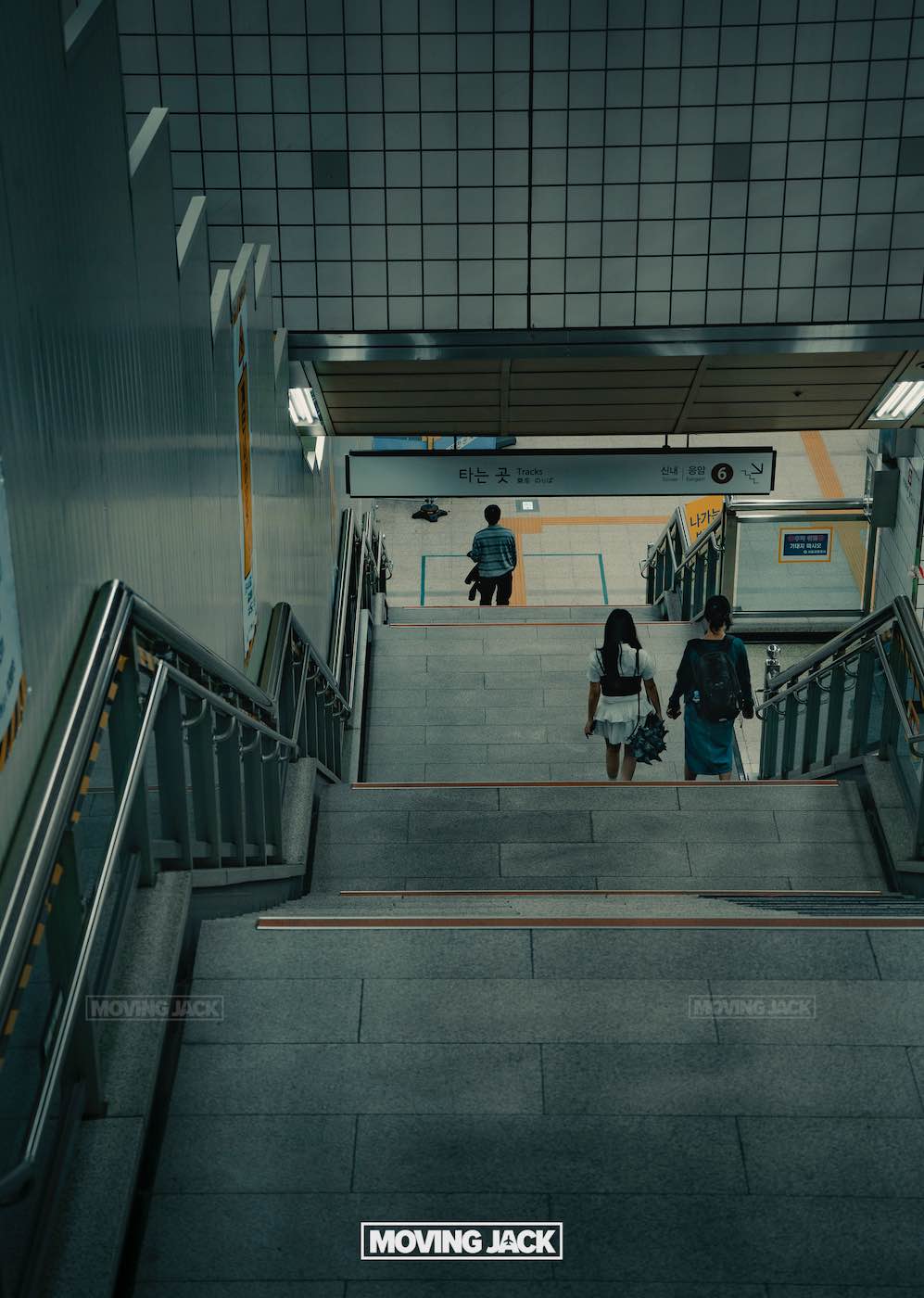
T-money Card
Using public transportation is easy thanks to the T-money card. You simply tap in and out at the gates, and you can recharge it at any station or convenience store. The same card works for buses and taxis, which makes life much easier.
Subways run until midnight on weekdays and until one in the morning on weekends. After that, night buses cover the main routes, though they come less often and cost slightly more. Taxis are reasonably priced for short trips, but can add up a bit during peak hours or late nights.
Where to get the T-Money Card? You can buy it at any ticket vending machine at any subway station, or at most convenience stores like the CU and GS25.
Climate Card
There is also a special option called the Climate Card, which offers unlimited subway rides for one day at 5,000 won. It sounds like a good deal, but unless you plan to travel extensively, you probably will not use it enough to make it worthwhile. Since a regular subway ride is just 1,470 won, you would need at least four or five rides to break even. Still, for days filled with sightseeing, it can be a smart choice.
Electric Bikes
If you prefer cycling, Seoul has some electric bike rentals through the Seoul Bike app or the bikeseoul.com website. Anyone over fifteen with a smartphone can rent one. You simply choose a station, pick a bike, swipe your card at the terminal, and start riding. It’s an easy system, but not as cheap as I expected. Costs add up quickly, and dedicated cycling lanes are very limited in Seoul, which can make navigating the city a bit challenging. Still, it is a fun way to explore parks or the Han River paths.
Taking the Bus
Buses are another great option for getting around the city. Sometimes I even prefer them over the subway because you get to see more of Seoul from the window. It feels like a mini city tour every time. You can use your T-money card to pay for the ride, and the routes cover nearly every area.
One thing I kind of dislike about the bus in Seoul is that many are not stroller-friendly. Most buses are like ‘tour buses’ where you go up a stair first and have seats left and right instead of buses that have more space for strollers or wheelchairs.
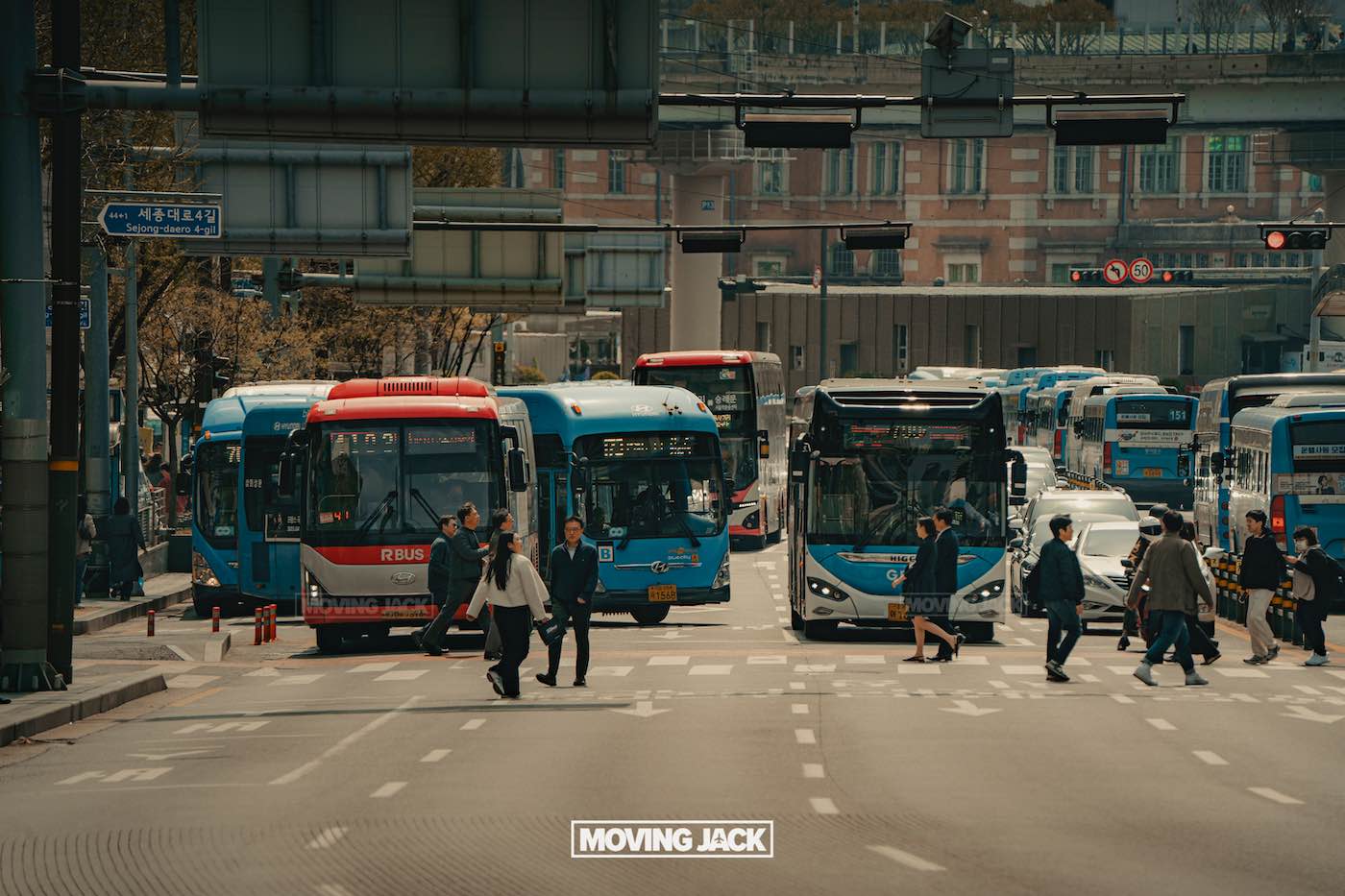
Driving in Seoul
If you’re going to spend several years in Seoul, getting a car could be a smart choice. Cars are fairly cheap over here, actually! But that’s only the case for Korean brands such as Hyundai, Kia, and Genesis.
Pros and Cons of owning a car in Korea:
Pros:
- More flexibility, especially with kids, it’s way more convenient than the subway.
- Korea is super safe, no need to worry about your car getting stolen or damaged.
- Gas is pretty cheap, a full tank is about 40 dollars ( but this can change, obviously)
- Summers are hot and winters are cold, so driving in your own car is really nice
Cons:
- Many traffic jams, up to the point where it’s almost impossible to get out of the city on the weekend.
- You’ll have to deal with insurance, maintenance, repairs, and perhaps any accidents that might occur in Korea, which can be a bit of a hassle.
- Parking spaces are not available everywhere, and many parking spots inside parking garages are narrow.
- Traffic is quite hectic, and crossroads and traffic lights are confusing at times, in my experience. And I’ve been driving a car a lot in Iraq, can you imagine?
Daily Life Essentials
In this chapter, I’ll cover everything related to getting food, supermarkets, healthcare, apps, and other daily essentials I use in Seoul.
Food
Groceries and eating out can be either cheap or expensive, depending on what you want.
Locally produced rice, tofu, and Korean food are very cheap, especially from traditional markets. But if you want imported cheese, pasta, or cereal, you’ll pay two or three times what you would in the West. Also, Korean BBQ is quite expensive. We rarely go to eat BBQ, maybe once a month.
What are the top food delivery apps used in Seoul? Coupang Eats!

Examples:
- Full Korean meal at local restaurant: ₩10,000 ($7)
- Street food dinner for 2: ₩15,000 ($11)
- Imported cereal: ₩12,000 ($9)
- Cappuccino: ₩7,000 ($5)
- Western brunch: ₩25,000+ per person
We buy groceries 80% of the time through Coupang, which is the main online store in Korea to buy just about anything. It’s convenient but also more expensive than markets.
We also visit Costco once every 2 months. Much more affordable, but you have to buy in bulk. There are several locations across Seoul.
My take: Personally, and this may be an unpopular opinion, I’m not a huge fan of Korean food. I really like Korean BBQ and sometimes eat bibimbap, but we usually go for international food. I make dinner at home about 4 times a week, and on other days, we order something through Coupang Eats, but it is rarely Korean.
Supermarkets we often visit:
- E-Mart (iPark Mall)
- Lotte Mart (Seoul Station)
- Costco (Several Locations, you can get a Costco card, which you need to get in at the entrance. Costs about 25000 won/15 dollars.
Which grocery delivery services operate in Seoul for expats? Everyone uses Coupang!
Trash and Recycling
This confused me so much when we first arrived.
You need to buy official trash bags, which are colored and have Korean text on them. Each district has its own bags, so you buy the ones for your area. We get ours at CU or GS25 convenience stores. They come in different sizes, and they’re not cheap, maybe 20,000 won for a pack of 20 large bags. This is basically your trash tax.
Here’s how it works:
General waste goes in the official colored bags (usually white/slightly greenish with text). This is stuff that can’t be recycled, like food-contaminated paper or broken items.
Food waste goes in a separate bag, depending on your building. Some apartments have a food waste system where you weigh it and pay per kilogram. Others provide special bags. We always get 5-liter bags at the CU, which are yellow.

Plastic and Cans go in transparent bags, which you don’t have to buy special bags for at the CU, but can get at the Daiso, and are very cheap. Plastic bottles, cans, and glass all go in the same bag, at least in our neighborhood.
Paper and cardboard can be put with the trash outside in a cardboard box.
Large items like furniture need special stickers that you buy and attach before putting them out. Or just sell on Karrot instead. Our building management helps with this.
Collection days vary by neighborhood. At our building, we can put out the trash any time we want.
The system feels a bit complicated at first, but after a month, it becomes automatic.
One thing that shocked me is how seriously Koreans take this. If you mess it up, the trash just sits there with a note, or you’ll get a warning written on a note that hangs in the hallway. But once you get it right, it’s actually a pretty good system.
Public Facilities
One of the things I really like about Seoul is the incredible facilities that public spaces have. Every park, mall, and museum has really clean and well-maintained toilets, for instance. And at parks, you will find pressured-air machines to blow the sand off your shoes (really!), and even free mosquito spray.
Trash cans are never overloaded and are widely available. There are AC-cooled elevators to get you up a bridge to cross the road and lots of other things that make life just a bit easier.

Healthcare & Medical Visits in Seoul
Healthcare in Seoul is a much-debated topic. Let me start with the positive things:
- The quality of healthcare is really good.
- Plenty of highly skilled doctors and nurses, and equipment
- No long waiting times
- Similar to the American vaccination program and work system.
- Care for pregnant women is really good, especially at private clinics.
- Medicines and quick doctor checks are very cheap. We once had to visit a pediatric clinic for our son, walked in, saw a doctor within 10 minutes, and left 20 minutes later with medicine. Total cost: ₩12,000 ($9). In Europe, we’d wait days for an appointment.
The negatives:
- IF you experience a real emergency, let’s say you need to be operated right away. You need to pay first, and an amount of 20.000 dollars is not uncommon. While you will probably have an international health insurance that will cover it. They might still insist that the payment comes first before they do anything. This can be a very stressful and even dangerous situation if you can’t pay right away. Many credit cards have a limit, and getting that much money is hard.
- There have been many strikes in 2025 at hospitals, and I’ve heard several stories of patients being rejected at hospitals. They were sent away to try it at another hospital. Luckily, the strikes are over, but this is something that happens.
- I also heard a story of an ambulance that didn’t want to take in a patient because they said this person was on something, which wasn’t the case.
- In Korea, the mindset is like “if the doctor didn’t prescribe you anything, you weren’t treated”. Which is very different than how it works in my home country. So even when you have a cold (which is just sickening it out), they will give you something.
- Doctors also tend to prescribe antibiotics more quickly than I’m used to in my home country.
These are just my experiences, and if you’re actually considering living in Seoul, please keep them in mind.
South Korea’s National Health Insurance (NHIS) is mandatory for all residents, including foreigners, but there are exceptions. Please check with your own health insurance and company.
Our First Medical Visit
Our son caught a mild version of a disease that a lot of children at daycare caught. We walked into a nearby pediatric clinic at 11 am. The nurse took his temperature, the doctor examined him, prescribed medication, and we were out the door in 30 minutes!
The total cost, consultation, and three types of medicine were ₩12,000 ($9 USD). I actually laughed when the receptionist told me the price. In the Netherlands, the same visit would have cost ten times more.
Pro tip: I've had great experiences at Yonsei Gomdori Pediatrics clinic. Friendly staff, and most doctors speak English very well. Parking is available.
Pharmacies and Medication
Pharmacies (약국, yak-guk) are everywhere, usually near clinics. Most are open from 9 am to 8 pm.
Prescription medications are dispensed in small paper packets labeled by time of day, morning, afternoon, and evening, which is incredibly convenient. You rarely get full bottles of pills like in Western countries.
Common meds such as antibiotics, painkillers, or cough syrup are cheap, usually under ₩10,000. Some Western over-the-counter brands may not exist here, but local alternatives work just as well.
Dental Care
Dentistry in Korea is amazing. Cleanings cost around ₩50,000 ($37), and fillings or crowns are a fraction of Western prices. Most dentists speak decent English and use cutting-edge equipment.
Pro Tip: I had great experiences with the Seoul UN Dental Clinic in Hannam-dong. Super friendly staff and Dentists who speak English very well.
Hospitals and Emergency Care
Large general hospitals like Severance Hospital (we went here several times), Asan Medical Center, or Samsung Medical Center are top-notch. Many have dedicated International Clinics with English-speaking staff who help with registration, translation, and insurance paperwork.
Check out my complete Seoul Safety Guide.
Health Apps and Language Tips
If you ever need to find a specialist, type the Korean name plus “clinic near me” in Naver Maps, it’s surprisingly easy.
Neighborhoods and Where to Live
After years of exploring (and talking to dozens of other expats), here’s my honest take on Seoul’s most popular areas for foreigners:
Question: Where do most foreigners stay in Seoul? Itaewon long term, without a doubt. Myeong-dong for tourists.
ITAEWON (이태원)
The expat capital of Seoul. You could walk down the main street and hear five different languages in five minutes.
Vibe: International, energetic, a mix of Seoul and everywhere else. Brazilian food, Middle Eastern, Italian, it’s all here.
Itaewon is great for:
- First-time expats
- People are nervous about the language barrier
- Food lovers and night owls
- LGBTQ+

Our Life Here: We chose Itaewon, which is in Yongsan, because of its balance. We can walk to cafes and markets, my wife’s commute is doable, and there are a lot of playgrounds, and the beautiful Namsan Park is like a 15-minute walk from our house.
Our street is quiet, with a few bakeries around the corner, a CU (Can’t live without it!), and it’s a 10-minute walk from the daycare center.
Check out my full Itaewon walkthrough to get a good sense of what the area is like:
GANGNAM (강남)
Yes, that Gangnam! The one made famous by Psy’s song, “Gangnam Style.”
But beyond the pop culture, Gangnam is all about Seoul’s wealth, ambition, and modern life. There are mostly glass skyscrapers, department stores, and coffee shops (mostly Starbucks) on every corner.
Vibe: Fast-paced, polished, professional. It’s where Seoul’s high earners live and work, and where you’ll see most luxury brands and cars.
Best For:
- Corporate professionals
- Expats working at Samsung, Hyundai, or tech firms
- Those who want everything ultra-modern
My Take: Gangnam is nice to visit, but for our family, we preferred something more human-scale and mixed. I know several families who started in Gangnam, but moved to Itaewon after a year.

YONGSAN (용산)
Yongsan is at the center of Seoul. It’s a perfect mix of convenience, green parks, and authentic living. It’s basically the entire area below Namsan Tower.
Vibe: Central, diverse, evolving. You can find a sleek high-rise next to an old hanok, and that contrast is part of the charm.
Best For:
- Families
- Remote workers
- Expats who want a balance between local and global
HONGDAE (홍대)
If you want energy and nightlife, this is your spot. Although there are also quite a few foreigners here, I wouldn’t recommend living in Hongdae.
Hongdae is a creative spot, Hongik University is there, and hundreds of artists, musicians, and designers. Street performers play every weekend, and the walls are covered with murals, posters, and street art.
Vibe: Youthful, artistic, chaotic (in a fun way).
Best For:
- Young professionals
- Digital nomads
- Students and creatives
My Take: l love visiting Hongdae, it's a fascinating and fun area, but living there as a family? Probably not. That said, if I were single or in my 20s again, I’d move here tho.
SEONGSU (성수동)
Once an industrial district filled with factories and warehouses, Seongsu has changed to the Brooklyn of Seoul (I’ve never been to Brooklyn, but that’s what everyone says!). It’s the brick-style houses, fancy coffee shops, pop-up stores and events, and boutiques that make it a unique area. The area is actually quite large, much bigger than Hannnam-dong, which is also known for its fancy coffee shops, but Seongsu is an area you can easily spend an entire day.

Vibe: Hipster, creative, stylish.
Best For:
- Hipsters and entrepreneurs
- Digital creatives and designers
- Musiscians
My Take: I visit Seongsu often on weekends. It’s stylish and, despite the expensive brands, it still feels local and authentic. However, for families, it’s still a little impractical as it is quite far from the city center.
One time in Seongsu, our son was crying, and a girl came up to him and gave him a little, cute stuffed animal! It shows again how friendly Koreans are, and especially how much they adore kids.

MAPO (마포)
Mapo is one of the most balanced areas for cost, convenience, and local charm. It’s close to Hongdae but much calmer; you get all the access without the chaos.
Vibe: Local, family-friendly, authentic.
Best For:
- Families
- Expats wanting “real Seoul”
- Long-term residents
My Take: Mapo is probably the most underrated area in Seoul. If we hadn’t found our place in Yongsan, we maybe would’ve lived here.
How to Choose Your Neighborhood
Ultimately, your ideal neighborhood depends on your priorities:
- Easy Start (English-friendly): Itaewon, Yongsan
- Family-Friendly: Yongsan, Jamsil, Mapo
- Trendy / Young: Hongdae, Seongsu
- Creative Scene: Seongsu, Haebangchon
- Quiet / Local: Seongbuk-dong, Mapo
- Prestige & Modern Comfort: Gangnam, Hannam-dong
My Advice: Don’t rush to sign a long lease before arriving. Stay in a serviced apartment (We stayed in Insadong Suites) or Airbnb for your first month and explore.
Walk through areas at night, test the time it takes to get to your work, and see which neighborhood feels right.
Pro Tip: check if there isn't any or too much construction going on close to the house!
Working Remotely In Seoul
When we moved to Seoul, I was already working on my blog and wanted to continue doing so. I work at home most of the time, but there are a lot of places you can work outside of home. It is no exaggeration to say that Seoul is one of the most comfortable cities in the world for remote workers. I’ve never been to a city with so many coffee shops, and every hour of the day, there are people working there.
Pro Tip: How can I get a prepaid SIM card for short-term stays in Seoul? Visit 7-Eleven or CU stores to buy SIM cards for 5 or 10 days.
A cup of coffee costs around five thousand won, which gives you access to a comfortable seat, fast internet, and usually a beautiful view and unique surroundings.
My favorite places to work remotely are:
- Foyer in Itaewon
- Die Syntese in Itaewon
- Kenya Coffee in Itaewon (great view of Namsan Tower)
- Starbucks Bukhansan Branch (a bit further from the city),
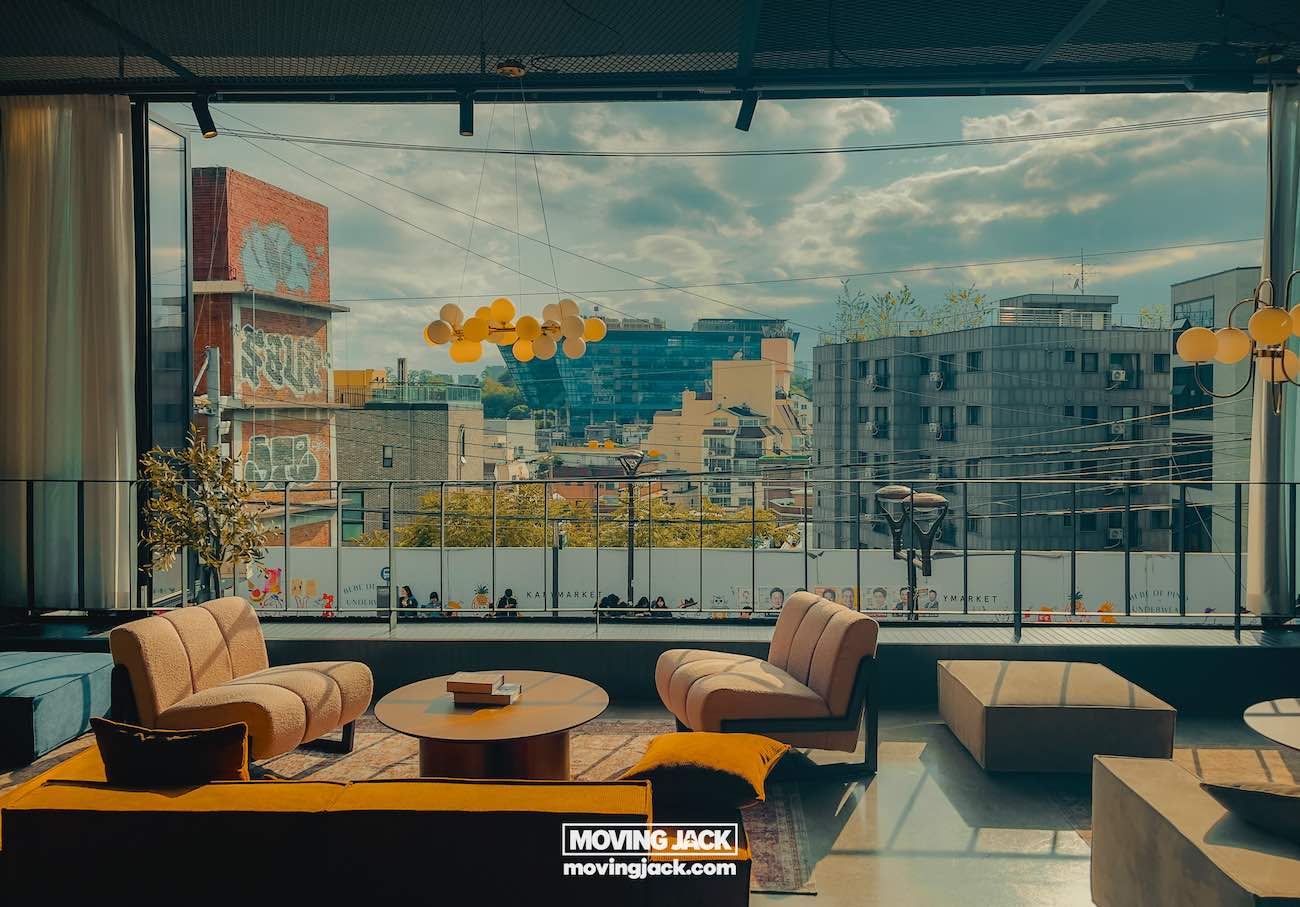
Coworking Spaces
There are many coworking spaces in Seoul. Places like Fast Five, WeWork, and Sparkplus offer memberships that range from 200,000 to 500,000 won.
Pro Tip: What is the best mobile carrier for living in Seoul? I've always used: Kt. Korea Telecom
Time Zones
The biggest challenge is time zones. Korea is nine hours ahead of UTC, which means early mornings for calls with Europe and late nights for the United States. It’s not super easy to keep in touch with family back home.
My Setup
My home office setup is simple. A large desk near the window, an ergonomic chair, an Apple Studio Monitor for editing photos, and my MacBook M1 and Mac mini M4 Pro connected to the wifi.
Pro Tip: How can I set up internet service quickly in Seoul? Contact Kt Korea Telecom
Living as an Expat Family
Before moving to Seoul, we had several options to choose from. We chose Seoul specifically because we knew it would be a great place to grow up the first 4 years of his life. And I would make the same decision if we could do it over again.
TL;DR
Daycare costs only $250/month and includes music classes, field trips, cooking lessons, and English classes. Getting around with a stroller in Seoul is not super easy because elevators are sometimes small, and streets in areas like Itaewon are steep and narrow. Air pollution surprised me; there are more bad air days than I expected.
Cultural Adjustments
Living in Korea also means learning how society works. First of all, I’ve read on several blogs the typical and maybe expected things like age hierarchy, the Bali bali culture, collectivism, and “never pour your own drink”. It’s not as strict as some of these blogs make it sound, and I wonder if they’ve ever really been in Korea.
The main thing you should know is just to be polite, perhaps a bit more polite than what you are used to. Which means making a small bow, saying thank you, taking something important with both hands, not talking too loudly, not being rude, and following the rules (not sitting on an elderly person’s seat in the subway).
If you do those things, you’ll be 100% fine, and you’ll notice Koreans are grateful for respecting their way of doing things.
How do Koreans feel about Americans? Korea is very pro-American. I know many Americans living here, and they are very welcome by locals.
Social Life
Making friends as an expat requires some initiative. There are countless expat communities, events, and Facebook groups, but building genuine friendships with Koreans takes time. I have found most of my friends through hikes, photography walks, cooking classes, or coworking spaces.
Korean friends are harder to make at first, mostly due to language barriers and different social expectations. I noticed that as an expat, you might have to take the first step to invite someone.
Why do Koreans work so many hours? It wasn't that long ago that Korea was a poor country. There is still this huge urge to thrive and succeed, hence why many Koreans work so hard.
Etiquette Essentials
There are a few small but important etiquette rules to remember.
- Remove your shoes when entering someone’s home or a daycare center.
- Use both hands when giving or receiving anything, especially money or gifts.
- Respect elders.
- Speak softly in public spaces.
- Small gestures like these show awareness of Korean manners and earn respect.
Check out my full guide on the first cultural impressions you’ll notice when arriving in Seoul.
Can Americans live in South Korea? Yes, many live here. They usually work for the American Embassy or the Army.
Language
English is maybe a bit less widely spoken in Seoul than you might expect. Seoul is very ‘American-influenced’ because of its history, but it’s not like everyone speaks English fluently. While you can certainly get far in daily life with gestures, translation apps, and kindness, learning some Korean makes everything easier and more rewarding.
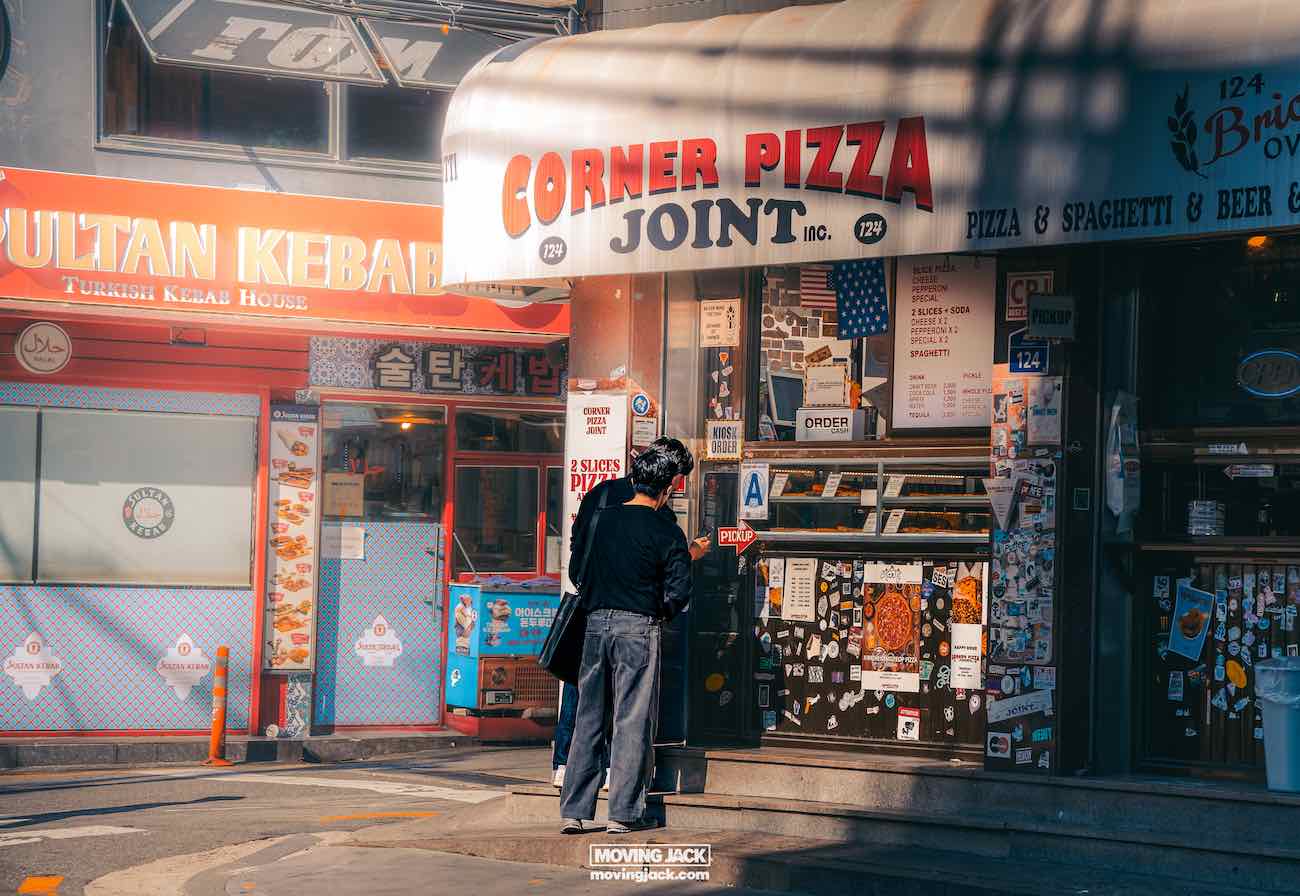
English in Seoul
In areas like Itaewon, Gangnam, and Myeongdong, you can get by in English pretty easily. Menus usually have pictures or translations, and younger Koreans know basic English. However, once you step outside the main areas, English quickly disappears.
At government offices, smaller stores, and car repair shops, communication often requires some apps and a bit of creativity. Fortunately, Koreans are very helpful, and even if they do not understand, they will try to assist you.
It happened to me several times when I was struggling with a vending or ticket machine that a Korean just walked up to me to help.
Learning Korean
The good news is that Hangul, the Korean alphabet, is quite logical, and the basics can be learned quickly. After memorizing it, reading signs and menus becomes much easier!
Grammar and speaking take more time, but progress comes quickly if you practice daily. My wife took private lessons once a week, and it truly surprised me how quickly she is able to make simple conversations and read signs.
Essential Phrases
Here are a few survival phrases I use every day:
- Hello: Annyeonghaseyo
- Thank you: Gamsahamnida
- How much is it: Eolmaeyo
- Please give me this: Igeo juseyo
Living in Seoul with Kids
Day Care
Day care is honestly amazing. Teachers are highly skilled, friendly, and actually adore the kids. I’ve talked with parents from the US, Denmark, and Finland, and they all said that the daycare in Korea is the best they’ve ever seen.
They do a lot of activities at daycare, such as:
- Music classes (an actual musician comes to school to play some songs)
- English class (with an English teacher)
- Cooking classes (yes, really, and it’s the cutest thing ever)
- Visiting a strawberry farm where they can pick their own strawberries
- Sports days
- Field trips
- Christmas parties
- Disney parties
- Korean Holiday Parties
- Pyjama parties
- Birthday parties… You name it.
At first, I found it a bit scary to bring my son to daycare for the first time, but I quickly saw how much he enjoys it and how amazing the teachers are
Pro Tip: Our son went to Summerhill DayCare in Itaewon, which is just amazing, like I mentioned.
Kidscafes
Kidscafes are amazing. There are a lot of them all over Seoul, and they are basically large indoor playgrounds where, at most of them, the parents can sit and have a coffee while their kids run around.
Our son loves them, and we visit these places regularly. They have trampolines, any toy you can think of, fishing games, ballpools, slides…
Tip: We often go to Kidscafe Des Enfants


Getting Around in Seoul with Kids
Getting around in the city with kids can be a bit of a struggle in Seoul. It’s actually one of the reasons why we bought a car.
The thing is, when taking the subway with a stroller, you have to take several elevators to get to the right platform. These elevators are often small, a bit old, there is a line, and they are often not easy to find.
Also, many streets are quite small and crowded. Especially here in Itaewon, the streets are narrow, steep, some are in poor condition, and are often crowded. So getting around with a stroller is not super convenient. In Gangnam, this will be different, where streets are wider, newer and more spacious.
Pros and Cons of Living in Seoul with Kids
The pros definitely outweigh the cons of living with kids in Seoul, here’s the summary:
Pros:
- Safe environment
- Daycare is the best
- A huge number of playgrounds everywhere, which are all well-maintained
- Many (free) activities for kids, such as children’s museums with activities
- Most restaurants have baby chairs
- It’s incredibly easy and fun to connect with Korean parents when you have kids! Random conversations happen to me almost every day when I’m out with my son.
Cons:
- Some days or even weeks have a lot of air pollution
- Not all neighborhoods are easy to get around in with a stroller
- City is not super stroller-friendly overall, in my experience.
Schools
Our son has only been in daycare, so I don’t know much about schools in Korea. Will update this if any information comes up!
Expat Community
Seoul’s expat community is large and very diverse. With more than 2.7 million registered foreigners, you will find people from every continent living and working here.
It didn’t take long before I was added to several expat group chats. I met some other parents at daycare, and overall, it’s just easy to connect with other expats. Here are some of my ways to connect with other expats:
Building Friendships
Our closest friends in Seoul come from all over the world. We met one family at a local playground through our son’s daycare, another family in a mall, and at my wife’s job, of course.
Korean friends take longer to make, but once they open up, the friendships is real. Koreans are loyal, generous, and curious about other cultures.
Where to Connect
An easy way to meet other expats is through online communities like the Facebook group “Seoul Expat Community,”. I joined a photography meetup in Hongdae that turned into some connections.
My wife once signed up for a meeting in Seoul through Time Left, which is a great way to meet foreigners, but also Koreans.
Most expats use the app Kakao Talk to text, which is kind of like WeChat or Whatsapp but with more functionalities.
Community Balance
It is easy to stay within the expat bubble, especially in areas like Itaewon, but I recommend reaching beyond it. Personally, I don’t even like to stay inside the expat bubble; I’m living in Korea to learn about other cultures! Spending time in local markets, community events, or Korean classes helps you understand the culture in ways you cannot from staying in the expat bubble.
Experiences, Final Thoughts & Tips
Seoul has been my home for 2 years, with 2 more years to go, longer than I’ve lived in China and the Middle East. Overall, the experience was great, and I would choose Seoul again if we could do it over.
Here are my experiences and final thoughts on living in Seoul as a foreigner:
TL;DR
Seoul feels very Western compared to other Asian cities, so if you’re looking for a real culture shock, this isn’t it. It’s safe, stable, the daycare is fantastic, Soul is affordable with the right decisions, and Seoul has tons to explore, but traffic and crowds can test your patience. You’re 2-3 hours from Okinawa, Tokyo, and Shanghai, which makes exploring Asia easy.
Traveling Options while living in Seoul
Starting your expat journey is not just about sitting in an office in another country, but about living in a different culture and exploring! Living in Seoul means there are plenty of options for exploring.

Exploring Seoul
One of our favorite pastimes is wandering through different neighborhoods. Each area feels like a city of its own.
Insadong is filled with art galleries, Hongdae bursts with clubs and bars, Gangnam has fancy malls and luxury stores, while Bukchon Hanok Village is all about traditional Korean houses, called hanoks, that make you feel like you’ve stepped back in time.
And all around Seoul, there are a lot of fun places to visit, like Seoul Plaza, shown below on the left, where they hold many events, and the Cheonggyecheon River, shown on the right, where you can relax in the heart of the city.


There are countless museums and cultural centers too, such as the War Memorial Museum of Korea (great playground for Kids outside), Leeum Samsung Museum of Art (really cool exhibitions, been here twice), and the Audeum Museum about the evolution of sound speakers (my mind was blown!). Most have excellent English explanations and are family-friendly.
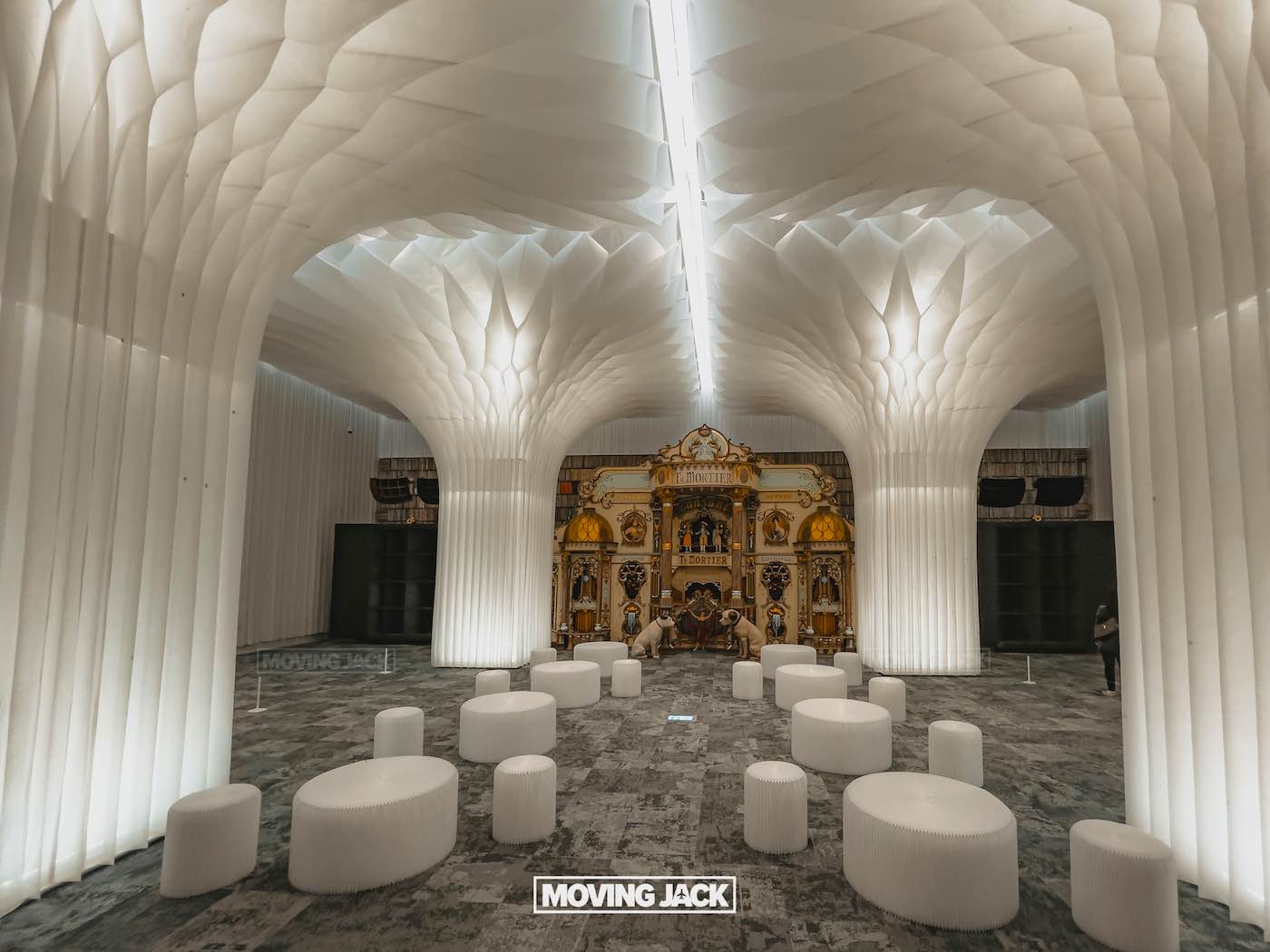

Nature Within the City
Seoul is surprisingly green. You can see Mountains all around the city, and hiking is like a national sport. Bukhansan National Park is the most famous, located only 30 minutes from the city center. The trails are well-maintained, and the views of the city from the peaks are epic.
In spring and autumn, the parks are full of families picnicking. The Han River is another great place to hang out.

Day Trips
Like I mentioned earlier, getting out of the city for the weekend with a car is almost impossible. You’re best bet is to take a train somewhere. We went to Busan, which takes about 2,5 hours with the fast train, very convenient!
But in November, we tried to go to Gyeongju, the old capital of Korea, by train, but for weeks, all train tickets were sold out, crazy! So, day trips outside Seoul are not easy unless you can go during the week.
Going Abroad
When you live in Seoul, you are surrounded by a lot of amazing countries and places you can visit with a 2 or 3-hour flight.
- Okinawa (2.5-hour flight, amazing place!)
- Phuket (6-hour flight)
- Shanghai and Beijing (1,5 hour flight)
- Hanoi (5-hour flight)
- Tokyo (2,5-hour flight)
- Jeju (2-hour flight)
So we often take this opportunity to explore more of Asia.
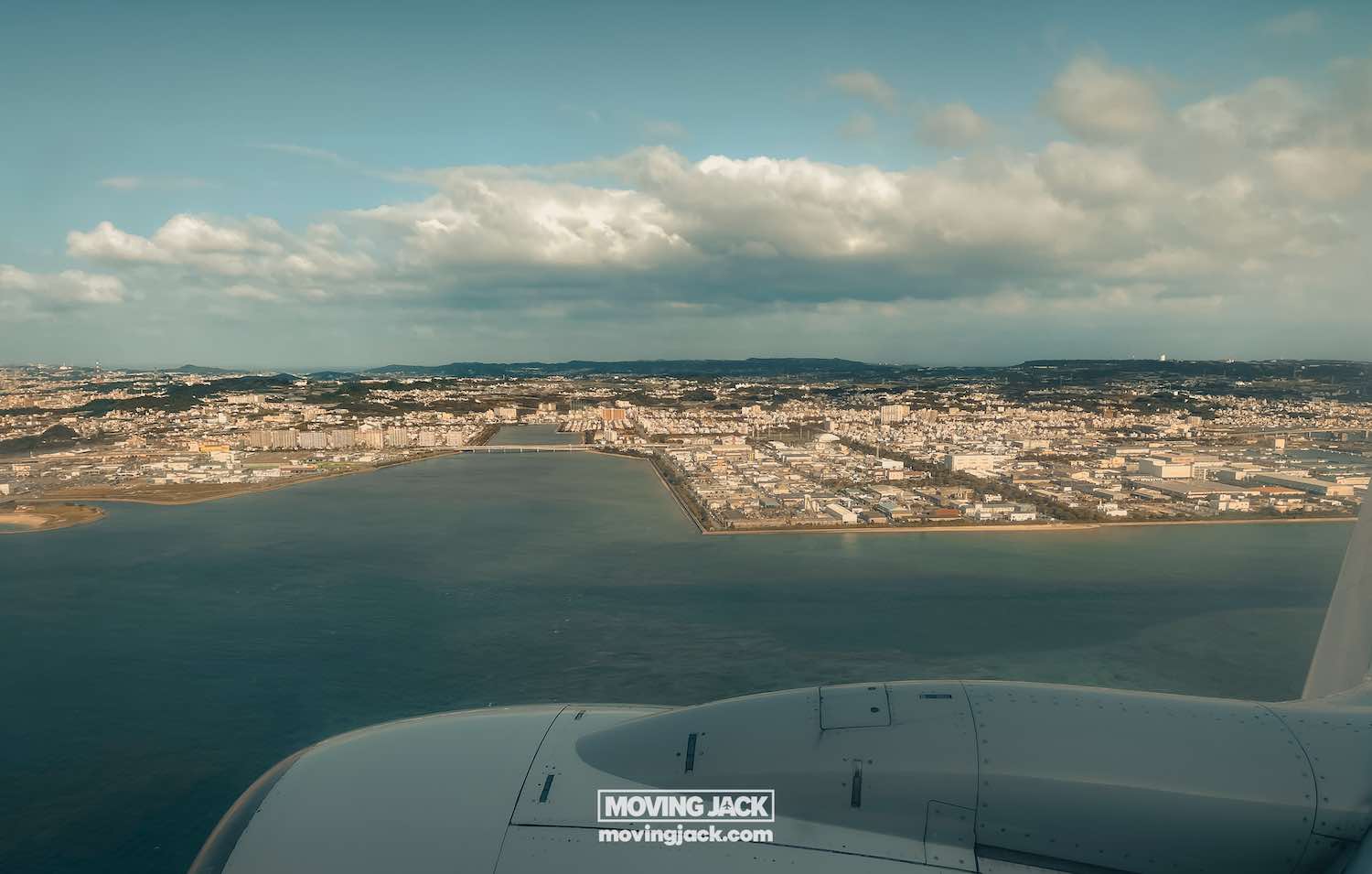

Cultural Experiences
We have been to everything, like cooking classes, weddings, birthday parties, pottery workshops, hikes, museums, the zoo, and more. There are a ton of things to do in Seoul, which is one of the reasons I like this city so much.
Check out my complete guide about things to do in Seoul.
Entertainment and Nightlife
For those who enjoy nightlife, there is a lot to choose from in Seoul:
- Karaoke rooms
- Rooftop bars to late-night
- Street food alleys
- Clubs
- Even having a beer at a CU or 7-Eleven is an option!
The city is both lively and safe, even after midnight. The most popular nightlife areas are Itaewon and Hongdae, but there are also a lot of smaller, lesser-known areas that have great nightlife like Jonggak Avenue of Youth.

Challenges of living in Seoul
Life in Seoul is an amazing experience, but it comes with some challenges that every expat should know:
Cultural Differences
Koreans are very polite but sometimes indirect. Sometimes people will not say no directly, and understanding nuance is essential. Workplace hierarchies and social formalities can also feel strict to foreigners used to more casual interactions.
Another thing is the emphasis on appearance. Everything is expected to be neat, and I sometimes feel “underdressed” in my regular jeans. After some shopping, I wanted to blend in a bit more and adjusted to the Korean style of dressing, which is basically a lot of white, beige and black.

The working culture can differ a lot if you work at a Korean company or an international one. I’m used to being very direct (I’m Dutch!), but that’s not how people are in Korea, especially in a working environment. Getting higher up in a company is very important to most Koreans, and I’ve heard this can cause some tension in the work environment.
My take: However, when moving abroad, you have to view these cultural differences as part of the adventure. When I moved to China, it was a totally different world.
You have to embrace it and go with the flow; otherwise, you will not enjoy living abroad. You have to see the fun side of all these differences, learn from it, share it with friends, and perhaps adapt what you like and would like to pass on to others.
When we lived in Iraq, we always got food like cookies from neighbors. We really liked this idea, so we did the same here in Korea and offered cookies and snacks to our neighbors in the building.
Air Quality
Seoul occasionally struggles with air pollution, especially in late winter and spring. Air purifiers are very common in homes and offices. It surprised me a bit that the air quality is poor for so many days. It’s more than I expected.
There are also not that many electric vehicles compared to China, so you often smell car and motor fumes, especially when walking past a busy road.
Fun fact: The famous Namsan Tower colors either green, yellow or red depending on the current air quality!
Space and Privacy
Apartments in Seoul are smaller compared to Western standards, and outdoor personal space, like a garden, is limited. The city can feel very crowded, especially on weekends. Somehow, it often feels much more crowded than in Shanghai, while there are more than twice as many people living in Shanghai.
Work-Life Balance
For those working in a local company, long working hours can be tough. The culture values hard work and dedication, which sometimes leads to overtime or after-hours gatherings, also on weekends. I know an expat who works for Coupang, the online store, and he has to work overtime a lot on weekends, and there aren’t many days off.
Getting Around
Traffic jams are probably my main issue with Seoul. A 4km/2 mile drive in the city can take up to 45 minutes one way. Especially with our toddler, this is a bit annoying.
There are also very few bicycle lanes, and basically nobody drives a scooter except for a few delivery scooters. I loved driving my electric scooter in Shanghai; it was so easy to go anywhere I wanted, but in Seoul, that’s just not possible.
Another thing is that almost all cars have tinted windows, as shown below. These are often so dark that you cannot see who is driving, or whether they even see you coming. Eye contact is not possible. I found this to be a bit dangerous and odd.

Pros and Cons of Living in Seoul
So let’s break down the pros and cons of living in Seoul as a foreigner/expat:
Pros:
- Safe
- Friendly locals
- Every neighborhood is different
- Lots of green, parks, mountains, hiking opportunities
- Free Museums
- City is clean overall
- A lot of places to explore
- Seoul is a modern city with many conveniences, like ordering food. We have a code lock on the door, so no keys! Pay by phone everywhere.
Cons:
- Traffic jams (way more than what I was used to in Beijing or Shanghai)
- Air pollution
- Korean working culture can be a struggle to navigate
- Groceries are expensive
- Very crowded, museums and restaurants are often fully booked, even at times you don’t expect it. At many museums, there will be a long line of cars(!) already outside the parking lot.
Quick Questions Answered
Do I need to speak Korean to live in Seoul?
No, but it helps a lot. You can survive in areas like Itaewon with just English, but learning basic phrases and reading ‘Hangul’ makes everything easier. My wife took weekly lessons and picked it up surprisingly fast.
Is Seoul safe?
Extremely. I leave my laptop on a cafe table when I go to the bathroom, and it’s always there when I get back. Our son plays outside, and I don’t worry about him. Pickpocketing is almost non-existent. Crime is so low that it’s one of my favorite things about living here. I wrote a complete safety guide if you want more info.
Can I drink the tap water?
Technically, yes, I know some who do, but most people don’t. We have a water filter installed in our apartment, which came with the place. Many Koreans buy bottled water or use filters. The tap water is safe, but it doesn’t taste great, so I don’t recommend it.
What’s the best neighborhood for families?
Yongsan, where we live, is perfect for families. Lots of parks, playgrounds, international schools nearby, and it’s central. Mapo is also great and more affordable. Check out the Neighborhoods section above for the full breakdown.
Do I need a car?
Not really, but it’s convenient if you have kids. We bought one because dragging a stroller through subway stations with our toddler was exhausting. If you’re single or don’t have kids, the subway or a taxi every now and then is honestly better than driving.
How expensive is Seoul compared to other cities?
About the same as Amsterdam or slightly cheaper. More expensive than most Asian cities but cheaper than London or New York. Your lifestyle matters more than the city itself. Seoul actually offers a lot of affordable and free activities, including many museums!

Useful Resources and Contacts
These are the actual services and groups I use regularly:
Real Estate: Alice Realty helped us find our apartment in Itaewon. She speaks English well and knows the expat-friendly buildings.
Healthcare: Yonsei Gomdori Pediatrics (Itaewon) for kids. English-speaking doctors, parking available. Seoul UN Dental Clinic (Hannam-dong) for dental work. Friendly staff, good prices.
Daycare: Our son goes to Summerhill DayCare in Itaewon. Amazing teachers, lots of activities, and they actually care about the kids. It’s one of the best decisions we made.
Apps I Already Mentioned: Kakao Talk, Naver Map, Papago, Coupang, Karrot, Coupang Eats.
Internet Provider: We use KT (Korea Telecom) for internet and phone. Setup was easy, 1Gbps fiber costs about $44 per month.
Shopping: Costco (need a membership, costs about $25) E-Mart at iPark Mall Coupang for online orders
Transportation: T-money card (buy at any subway station or convenience store) Kakao T app for taxis or K-Ride (easier to connect credit card)
These are the resources we use. There are way more options out there, but these work well for us.
Is Living in Seoul worth it?
Having lived in China (Beijing and Shanghai), the Netherlands, and Iraq, I know quite a few places to compare Seoul with.
Overall, Seoul is just a very stable option to live as an expat; it’s safe, plenty of things to do, it’s not super expensive when you plan a bit, people are very friendly, and daycare is cheap with amazing teachers.
What I love most about Seoul is how it constantly surprises me. One day, you’re discovering a centuries-old tea house; the next, you’re eating fried chicken in a restaurant you found in an alley like in Ikseon-dong.

Our son now knows some Korean words, our Korean neighbors greet us each morning, and even the security guard downstairs waves when we pass by. These small connections turn a foreign city into a real home.
Personally, I do miss a bit of the adventure we had in Iraq and the culture shock I experienced in China. Seoul is very Western. Which is nice, but it’s also missing a bit of a culture shock effect that I personally like so much, because then you really have the feeling of being in a different world.
Seoul is not perfect, I guess no place is. The winters are cold (although nice somehow), the summers are hot and humid (my least favorite time of the year), and some of the bureaucracy can test your patience. But Seoul is also diverse, efficient, and very alive.


So, is it worth it? Yes, definitely. However, if you’re considering moving here, come with an open heart. Embrace the pace, learn a few words of Korean, and let yourself get lost every now and then.
You will find, as we did, that Seoul is not just a place to live. It is a place where you can keep on exploring and where there is always something new around the corner.





![Renting a car in okinawa: insider guide + 8 best budget tips [2025] 58 living in seoul A yellow and white compact suv is parked next to a silver sedan in a modern apartment parking lot on a sunny day, with blue sky and ocean visible in the background. -copyright-moving-jack. Com](https://moving-jack.com/wp-content/uploads/2025/10/okinawa-japan-car-rental-guide-asia-beach-holiday-tropical-ocean-outdoor-summer-copyright-moving-jack.com-13-3-95x95.jpg)
